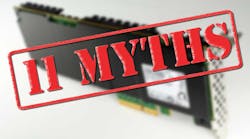This file type includes high-resolution graphics and schematics when applicable.
Embedded applications are subjected to harsh environments that include extreme temperatures, shock, and extraordinary read/write cycles. Standard consumer SSDs have a very short life in these environments. If designers cut corners in their designs by using consumer-grade storage, they may save money on the front end. But they pay dearly later on in terms of total cost of ownership and a short life of their product design. Then there’s the cost of a rolling repair that would make any designer yell, “I’ve had enough! Give me the best you’ve got!”
2. There’s more bang for the buck in higher-capacity SSDs.
The industry has learned that SSDs have their place and can’t be all things to all storage needs. High-capacity consumer-grade drives are all the rage, but what’s needed in the embedded world are SDDs that closely supply only the capacity needed. Therefore, designers can build tighter designs that consume less power, provide cost savings, and ensure better endurance—all in exchange for big (unused) capacities.
3. SSDs cost more than HDDs.
Many industrial applications are subjected to very harsh operating environments, deployed in difficult to reach/service locations, and run “mission-critical” applications. If these drives fail, not only are they costly service calls, but the lost productivity and damaged customer reputation can be unrecoverable. Embedded SSDs are much more durable than HDDs and withstand harsh environments much more reliably. The net benefit is a lower total cost of ownership (TCO) for SSDs relative to HDDs.
4. SSDs are only suited to high-performance applications.
Many industrial/embedded applications don’t require high performance as much as they do very-small-footprint storage (many less than half the size of a standard HDD). Such applications’ storage requirements also call for low power and lower capacities—for example, 16 to 64 GB—which is sufficient to boot an embedded operating system with some light data logging. Embedded SSDs come in a variety of small formats and typically consume half the power of a standard HDD, with capacities as low as 8 GB.
5. A single standard form factor should be fine for all embedded SSDs.
Some micro-designs require storage with footprints smaller than the standard SATA connector format. Overall embedded product designs will dictate the storage form factors, which is exactly why smaller formats such as M.2 made their way to the market and are now popular in industrial/embedded applications.
6. The higher cost of SLC flash, versus MLC flash, isn’t worth it.
Single-level cell (SLC) maintains significant advantages over multi-level cell (MLC): greater endurance, better tolerance to high/low temperatures, and longer product availability. If endurance and/or operating temperatures are critical considerations in an application, and there’s room in the budget, then SLC is the best choice. Many SLC drives have 30X (or more) greater endurance over standard MLC and typically feature higher write performance. Furthermore, they withstand temperatures much better, with lower risk of bit errors.
A less obvious consideration is the lifecycle/availability of SLC versus MLC. SLC revisions are much less frequent than those of MLC—for example, four to five years for a single SLC die versus just one to two years for MLC. Another way of looking at the contrast is that MLC-based designs must be requalified at least twice for every one SLC design. Depending on test and qualification expenses, SLC is often a lower-cost solution in the long run.
7. MLC and SLC are my only industrial embedded choices.
If budget is a concern, certain industrial-grade, mid-level alternatives on the market offer more endurance over standard MLC—at a lower cost compared to SLC. These go by several names: eMLC, pseudo-SLC, and iMLC. They use different methods to gain better endurance. Some, such as Virtium’s iMLC line, combine industrial-grade components and unique firmware programming to achieve around 7X better endurance compared to standard MLC.
8. Legacy PATA designs must be scrapped as spinning PATA drives no longer become available.
Some parallel AT attachment (PATA) embedded designs remain viable, and it’s not cost–effective to redesign their storage for a different interface. PATA, therefore, lives on. Virtium, for example, recently released its PATA SSD to fill a significant need faced by designers when replacing spinning PATA drives in legacy embedded designs.
9. PCIe will replace SATA.
The tried-and-true serial AT attachment (SATA) interface is deeply entrenched in the embedded market. SATA still remains the standard of choice as its widespread availability, mature technology, lower power, compatibility, and more-than-adequate performance is a good fit for most embedded designs. PCIe will become more common, but the expectation is that it will coexist with SATA in the embedded/industrial space for several years to come.
10. NVMe is ready for prime time in embedded-systems SSDs.
While Non-volatile Memory Express (NVMe) is a buzzword often thrown in around discussions about enterprise applications, it’s still in its infancy in the embedded world. Fully taking advantage of NVMe involves drives with large capacities—drives that aren’t required in embedded applications. Also, while NVMe is supported in later Windows, Mac, and Linux operating systems, it may be harder to implement with a custom OS.
11. SSDs are a “black box,” making it difficult to monitor drives’ health and endurance.
SSDs continue to evolve in step with advances in controller and firmware technologies. Today’s controllers are as powerful as entire computers were just 10 years ago. Advanced firmware algorithms can now support highly integrated software tools for users to “look inside” an SSD and monitor wear patterns and other operational information. Solutions such as Virtium’s vtView software can better predict the life of drives and enable embedded designers to make adjustments to their designs to improve overall performance and endurance.
Looking for parts? Go to SourceESB.


